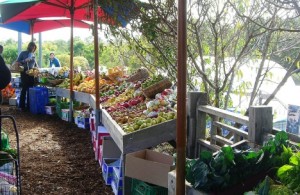By Tabitha Alterman – motherearthnews.com
There’s growing evidence that industrial food just ain’t what it oughta be. Lucky for us, the path to super-nutritious food at affordable prices offers many entry points. We’ll pilot you through the diverse options in this guide to shopping smart and eating better food.
Buy In Season
WHY? Like most goods and services, foods cost less when they’re abundant. Eat foods during their peak season for scaled-down price plus amped-up quality. Foods that get to you quickly lose less flavor and nutrients, and you can enjoy varieties of produce that can’t survive long-distance shipping. Buying in-season foods directly from farmers is the easiest way to save money on better food — especially at the end of market day, and especially if you’re willing to buy less-than-perfect items. Buying in season is also the best way to get good prices on more-expensive organic produce.
HOW? Arm yourself with strategies for eating fresh during any season with the comprehensive resources we’ve compiled for you on our website at How to Eat Seasonally.
WHAT’S NEXT? If you eat seasonally, it’s easier to …
[pro_ad_display_adzone id=”110028″]
Buy Locally
WHY? When you spend $1 on supermarket food, not much of it goes to the actual producer. Some of your dollar goes to the person who grew it, while some goes to the person who picked it. Some goes to the companies who processed, packaged and transported it, and some to the firm that designed the packaging and advertising. Finally, some of your dollar ends up in the hands of the grocery store owner, and also in the hands of the store’s employees. The fewer middlemen, the less the seller will have to charge you.
HOW? Find farms, restaurants, co-ops, farmers markets and other great local-food resources on our website (see How to Find Local Food and Farmers – US Based). In addition, pickyourown.org has an international database that provides local listings of pick your own (also called U-pick or PYO) farms in the United States, Canada, Britain, Australia, New Zealand, South Africa plus other countries.
WHAT’S NEXT? Money spent locally stays in your community, which is ripe with resources to …
Join Forces With Community Supported Agriculture
WHY? Community supported agriculture (CSA) programs used to be charming novelties in certain neighborhoods that enjoyed eco-abundance, but their huge surge in popularity in recent years means CSA programs are now available nationwide — more than 4,000 are listed in the US based Local Harvest database. A CSA program is essentially a local-farm subscription service, in which a group pays the farmer directly for the food she delivers. You can save money on super-fresh, high-quality produce, and many CSAs also offer meat, eggs, dairy, honey, flowers and herbs. Some offer free or lower-cost subscriptions to those who donate time or qualify for low-income shares.
HOW? Find a CSA program in your area through the Robyn Van En Center or Local Harvest and start buying better food now.
WHAT’S NEXT? Now that you’ve acquired so many great ingredients, you’d better believe you can start saving big if you …
Cook Your Own Food
WHY? The absolute fastest route to grocery savings is the path to your kitchen. Avoid eating out or buying packaged foods by cooking your own meals from whole, unprocessed ingredients. Simple breakfasts of whole grains, fruit and eggs eaten at home will kick-start your day with long-lasting energy. Take your own lunch to work or school for a meal guaranteed to be much more flavorful than fast-food or vending machine fare. Save time at dinner by spreading the work among family members and prepping double batches of dinners that freeze well. And save money all around by making your own staples, such as stock, pasta sauce, butter, condiments, yogurt and many others. You’ll learn quickly that you can make better food than any of those packaged versions at the grocery store.
Did you know you could save at least half the cost of fancy fresh cheese by making it yourself? Plus it’s fun, I promise. And what about fancy artisan bread? Whoa nelly! Delicious rustic loaves from fine bakeries can cost up to $7 a loaf, but you can make your own loaves of comparable quality — again, I promise — for about 50 cents each. You’ll also be able to use more nutritious flour made with whole grains. Really serious about getting high-quality food at awesome prices? Grind your own grains for peak freshness and flavor. Grain mills start around $25 (though some nicer ones are in the hundreds), and if you buy 50-pound bags of whole grains, you could make that back with your first grain purchase.
HOW? Read Motherearthnews.com’s articles on whole grains, fabulous homemade bread recipes, plus easy tips to keep more lunch money in your pocket. Check out a long list of their reader’s excellent grocery budget tips in How Do You Save Money on Groceries? and while you’re on our website, visit our Real Food page for all kinds of recipes and cooking information.
WHAT’S NEXT? If you want to get in even closer contact with your food, why not …
Grow Your Own Food
WHY? A sure way to rock your world with superior flavor and better nutrition, and still save money, is by growing your own food. Rosalind Creasy, author of Edible Landscaping, saved $700 on groceries in 2008 when she grew a simple, 100-square-foot garden. Roger Doiron, founder of Kitchen Gardeners International, saved $2,000 from a 1,500-square-foot plot in 2009. Just think — grocery prices are even higher now.
Accumulating evidence is revealing the sad truth that today’s commercial fruits, veggies and grains contain fewer nutrients than their counterparts of yore, and many heirloom varieties are nutritionally superior to modern hybrids. Growing food yourself — with time-tested heirloom varieties, in healthy soil — is the best way to get those nutrients back into your diet.
If you’re unsure, start small! Try radishes, greens, zucchini, tomatoes, peppers and potatoes to start. Even a modest herb garden could save you big bucks, as fresh herbs are usually pricey. If you’re adventurous, start big! You can grow whopping quantities of food by using your front yard, too (if your community doesn’t forbid it). Many edibles, such as rainbow chard and climbing beans, are as beautiful as they are useful. No sun? Join one of the 18,000 community gardens dotted all over North America. Live in an apartment? You may be lucky enough to find a rooftop garden sprouting up near you.
HOW? Learn to grow better food and find gardens that need you with our deep archives (see Learn to Grow Food).
WHAT’S NEXT? Whether you grow it or buy it fresh, you can make that garden goodness last all winter long by learning to …
Click the below picture for a Wake Up World Only Exclusive Special Offer
Preserve Your Own Food
WHY? Even if you’re not growing food yourself, you can save up to 75 percent on home-canned and up to 80 percent on home-frozen foods if you buy the produce fresh during peak season. They’ll taste better than store-bought convenience foods to boot.
Drying foods is another way to concentrate flavor and nutrition. Dried fruits and veggies make wonderful, easy snacks, and you can save quite a bit on pricey mushrooms by buying them when you spot a sale, then drying them yourself to reconstitute later.
HOW? Search for “canning,” “drying” and “freezing” at MOTHER EARTH NEWS online to find plenty of articles about the basics.
WHAT ELSE? Just as you can preserve fresh foods for out-of-season eating, you can purchase seasonal dry goods at deep discounts and store them for later use. So why not …
Buy In Bulk
WHY? The price differences between packaged foods and plain, whole foods sold in bulk can be astounding. For example, you can save about 50 percent on pasta and peanut butter, and up to 70 percent on oats and popcorn. You may be surprised at how much you can find in bulk sections these days — everything from spices, herbs, tea and coffee to beans, grains, flour, olive oil and more. Buying clubs and food co-ops also offer tremendous savings to grocery shoppers who don’t mind planning ahead and working with others.
HOW? Look for the bulk section in your grocery or natural foods store. Connect with a food co-op or buying club through Coop Directory Service or United Buying Clubs.See Get to Know the Wonder-Working, Timesaving Pressure Cooker to learn how you can save even more by preparing foods efficiently with a pressure cooker.
WHAT ELSE? Buying food in bulk is a great way to save grocery dollars, but when it comes to the smartest money savings, you’ll want to …
Choose Wisely
WHY? Supporting a reduction in our nation’s pesticide dependence by choosing organic foods is worthwhile — the effects of industrial, chemical-based agriculture reach much further than what we ingest as individuals and the effects it has on our personal health. But sometimes we must make strictly budget-conscious decisions. If you can only access organically grown food some of the time, you’ll want to make the best choices. For example, fruits with permeable skin, such as strawberries, absorb more chemicals than thick-skinned onions and eggplants. And did you know that apples and celery top the list of pesticide-laden foods, while mushrooms and sweet potatoes are consistently clean?
HOW? The Environmental Working Group maintains the most up-to-date list of which conventionally grown foods are likely to be contaminated with pesticides and which are safest to eat: EWG’s 2011 Shopper’s Guide to Pesticides in Produce.
WHAT ELSE?
To continue reading, visit Mother Earth News or jump straight into one of the following sections.
One of the Quickest Ways to Grocery Savings? Pack Your Lunch!
Follow Your Own Soup Adventure!
[pro_ad_display_adzone id=”110027″]








